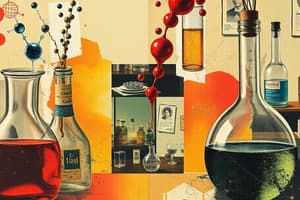Podcast
Questions and Answers
What type of matter has a definite shape and volume?
What type of matter has a definite shape and volume?
- Mixture
- Liquid
- Gas
- Solid (correct)
A compound can be physically separated into its constituent elements.
A compound can be physically separated into its constituent elements.
False (B)
What term describes a combination of two or more different substances that are not chemically bonded?
What term describes a combination of two or more different substances that are not chemically bonded?
mixture
Water (H₂O) is an example of a __________.
Water (H₂O) is an example of a __________.
Which of the following is a physical property of matter?
Which of the following is a physical property of matter?
Match the following types of mixtures with their examples:
Match the following types of mixtures with their examples:
Gases have a definite volume but no definite shape.
Gases have a definite volume but no definite shape.
How many known elements are there currently?
How many known elements are there currently?
Which of the following is an example of a physical change?
Which of the following is an example of a physical change?
Atoms are the smallest unit of matter that retains the chemical properties of a compound.
Atoms are the smallest unit of matter that retains the chemical properties of a compound.
What is the number of particles in one mole of a substance?
What is the number of particles in one mole of a substance?
The number of protons in an atom's nucleus is called its ______.
The number of protons in an atom's nucleus is called its ______.
Match the following terms with their definitions:
Match the following terms with their definitions:
Which trend would likely increase as you move from left to right across the periodic table?
Which trend would likely increase as you move from left to right across the periodic table?
Isotopes of the same element have different chemical properties.
Isotopes of the same element have different chemical properties.
What change is indicated by the formation of a precipitate?
What change is indicated by the formation of a precipitate?
Flashcards
What is matter?
What is matter?
Anything that occupies space and has mass.
States of matter
States of matter
Solid, liquid, and gas.
Element
Element
A pure substance consisting of only one type of atom.
Compound
Compound
Signup and view all the flashcards
Mixture
Mixture
Signup and view all the flashcards
Physical properties
Physical properties
Signup and view all the flashcards
Chemical properties
Chemical properties
Signup and view all the flashcards
Change of state
Change of state
Signup and view all the flashcards
Physical Change
Physical Change
Signup and view all the flashcards
Chemical Change
Chemical Change
Signup and view all the flashcards
Atom
Atom
Signup and view all the flashcards
Atomic Number
Atomic Number
Signup and view all the flashcards
Mass Number
Mass Number
Signup and view all the flashcards
Isotopes
Isotopes
Signup and view all the flashcards
Atomic Mass
Atomic Mass
Signup and view all the flashcards
Mole
Mole
Signup and view all the flashcards
Study Notes
Introduction to Matter
- Matter is anything that occupies space and has mass.
- Matter exists in three fundamental states: solid, liquid, and gas.
- Matter can be further classified into elements, compounds, and mixtures.
- Elements are pure substances consisting of only one type of atom.
- Compounds are pure substances formed by the chemical combination of two or more different elements.
- Mixtures are combinations of two or more different substances that are not chemically bonded.
States of Matter
- Solids: Solids have a definite shape and volume. Particles are tightly packed and vibrate in fixed positions. Solids do not readily compress.
- Liquids: Liquids have a definite volume but take the shape of their container. Particles are close together but can move past each other. Liquids flow and are slightly compressible.
- Gases: Gases have neither a definite shape nor a definite volume. Particles are separated by large distances and move randomly at high speeds. Gases expand to fill any container and are highly compressible.
Properties of Matter
- Physical properties: These can be observed or measured without changing the composition of the substance. Examples include color, odor, melting point, boiling point, density, and hardness.
- Chemical properties: These describe the ability of a substance to undergo a chemical change or reaction. Examples include flammability, reactivity with acids, and tendency to rust.
Elements
- Elements are the fundamental building blocks of matter.
- Currently, 118 elements are known.
- Elements are represented by chemical symbols (e.g., H for hydrogen, O for oxygen).
- Elements are arranged in the periodic table based on their atomic structure and properties.
Compounds
- Compounds are formed when two or more different elements combine chemically in fixed proportions.
- Compounds have unique properties that are different from the properties of their constituent elements.
- Compounds can be broken down into simpler substances through chemical reactions.
Mixtures
- Mixtures are combinations of two or more substances that are physically combined, not chemically bonded.
- Mixtures can be homogeneous or heterogeneous.
- Homogeneous mixtures have uniform composition throughout (e.g., saltwater solution).
- Heterogeneous mixtures have non-uniform composition (e.g., sand and water).
- Mixtures can be separated by physical methods (e.g., evaporation, distillation, filtration).
Physical and Chemical Changes
- Physical change: A change in the physical properties of a substance without changing its chemical composition. Examples include melting, freezing, boiling, and dissolving.
- Chemical change: A change in which one or more substances are converted into different substances. Evidence of a chemical change includes the release of gas, formation of a precipitate, or change in color.
Atomic Structure
- Atoms are the smallest unit of an element that retains the chemical properties of that element.
- Atoms consist of a nucleus containing protons and neutrons, with electrons orbiting the nucleus.
- Protons have a positive charge, neutrons have no charge, and electrons have a negative charge.
- The number of protons in an atom's nucleus determines the element.
Atomic Number and Mass Number
- Atomic number: The number of protons in the nucleus of an atom.
- Mass number: The total number of protons and neutrons in the nucleus of an atom.
Isotopes
- Isotopes are atoms of the same element that have the same number of protons but a different number of neutrons.
- Isotopes have the same chemical properties but different physical properties.
Important Concepts: Atomic Mass
- Atomic mass is the average mass of all the naturally occurring isotopes of an element.
- It is measured in atomic mass units (amu).
Periodic Table
- The periodic table organizes elements based on their atomic number and properties.
- Elements with similar properties are grouped in columns (groups or families).
- Elements are arranged in rows (periods) based on the electron configuration of their atoms.
Periodic Trends
- Periodic trends describe the changes in properties of elements as you move across or down the periodic table.
- These include electronegativity, ionization energy, atomic radius, and metallic character.
Mole Concept
- A mole (mol) is the amount of substance that contains 6.022 × 10²³ particles (atoms, molecules, ions).
- This number is known as Avogadro's number.
- The molar mass of a substance is the mass of one mole of that substance.
Studying That Suits You
Use AI to generate personalized quizzes and flashcards to suit your learning preferences.




